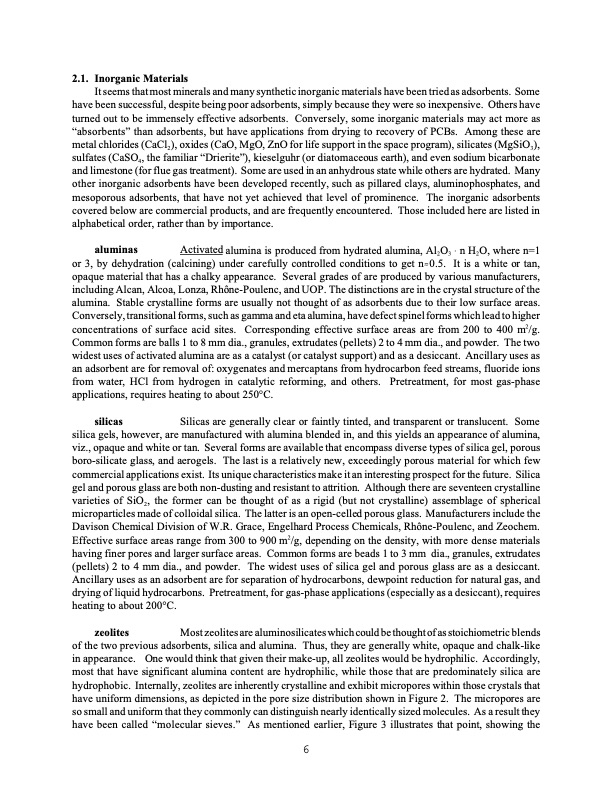
PDF Publication Title:
Text from PDF Page: 008
2.1. Inorganic Materials It seems that most minerals and many synthetic inorganic materials have been tried as adsorbents. Some have been successful, despite being poor adsorbents, simply because they were so inexpensive. Others have turned out to be immensely effective adsorbents. Conversely, some inorganic materials may act more as “absorbents” than adsorbents, but have applications from drying to recovery of PCBs. Among these are metal chlorides (CaCl2), oxides (CaO, MgO, ZnO for life support in the space program), silicates (MgSiO3), sulfates (CaSO4, the familiar “Drierite”), kieselguhr (or diatomaceous earth), and even sodium bicarbonate and limestone (for flue gas treatment). Some are used in an anhydrous state while others are hydrated. Many other inorganic adsorbents have been developed recently, such as pillared clays, aluminophosphates, and mesoporous adsorbents, that have not yet achieved that level of prominence. The inorganic adsorbents covered below are commercial products, and are frequently encountered. Those included here are listed in alphabetical order, rather than by importance. aluminas Activated alumina is produced from hydrated alumina, Al2O3 A n H2O, where n=1 or 3, by dehydration (calcining) under carefully controlled conditions to get n.0.5. It is a white or tan, opaque material that has a chalky appearance. Several grades of are produced by various manufacturers, including Alcan, Alcoa, Lonza, Rhône-Poulenc, and UOP. The distinctions are in the crystal structure of the alumina. Stable crystalline forms are usually not thought of as adsorbents due to their low surface areas. Conversely, transitional forms, such as gamma and eta alumina, have defect spinel forms which lead to higher concentrations of surface acid sites. Corresponding effective surface areas are from 200 to 400 m2/g. Common forms are balls 1 to 8 mm dia., granules, extrudates (pellets) 2 to 4 mm dia., and powder. The two widest uses of activated alumina are as a catalyst (or catalyst support) and as a desiccant. Ancillary uses as an adsorbent are for removal of: oxygenates and mercaptans from hydrocarbon feed streams, fluoride ions from water, HCl from hydrogen in catalytic reforming, and others. Pretreatment, for most gas-phase applications, requires heating to about 250°C. silicas Silicas are generally clear or faintly tinted, and transparent or translucent. Some silica gels, however, are manufactured with alumina blended in, and this yields an appearance of alumina, viz., opaque and white or tan. Several forms are available that encompass diverse types of silica gel, porous boro-silicate glass, and aerogels. The last is a relatively new, exceedingly porous material for which few commercial applications exist. Its unique characteristics make it an interesting prospect for the future. Silica gel and porous glass are both non-dusting and resistant to attrition. Although there are seventeen crystalline varieties of SiO2, the former can be thought of as a rigid (but not crystalline) assemblage of spherical microparticles made of colloidal silica. The latter is an open-celled porous glass. Manufacturers include the Davison Chemical Division of W.R. Grace, Engelhard Process Chemicals, Rhône-Poulenc, and Zeochem. Effective surface areas range from 300 to 900 m2/g, depending on the density, with more dense materials having finer pores and larger surface areas. Common forms are beads 1 to 3 mm dia., granules, extrudates (pellets) 2 to 4 mm dia., and powder. The widest uses of silica gel and porous glass are as a desiccant. Ancillary uses as an adsorbent are for separation of hydrocarbons, dewpoint reduction for natural gas, and drying of liquid hydrocarbons. Pretreatment, for gas-phase applications (especially as a desiccant), requires heating to about 200°C. zeolites Most zeolites are aluminosilicates which could be thought of as stoichiometric blends of the two previous adsorbents, silica and alumina. Thus, they are generally white, opaque and chalk-like in appearance. One would think that given their make-up, all zeolites would be hydrophilic. Accordingly, most that have significant alumina content are hydrophilic, while those that are predominately silica are hydrophobic. Internally, zeolites are inherently crystalline and exhibit micropores within those crystals that have uniform dimensions, as depicted in the pore size distribution shown in Figure 2. The micropores are so small and uniform that they commonly can distinguish nearly identically sized molecules. As a result they have been called “molecular sieves.” As mentioned earlier, Figure 3 illustrates that point, showing the 6PDF Image | ADSORBENT SELECTION

PDF Search Title:
ADSORBENT SELECTIONOriginal File Name Searched:
AdsorbentSel1B.pdfDIY PDF Search: Google It | Yahoo | Bing
CO2 Organic Rankine Cycle Experimenter Platform The supercritical CO2 phase change system is both a heat pump and organic rankine cycle which can be used for those purposes and as a supercritical extractor for advanced subcritical and supercritical extraction technology. Uses include producing nanoparticles, precious metal CO2 extraction, lithium battery recycling, and other applications... More Info
Heat Pumps CO2 ORC Heat Pump System Platform More Info
| CONTACT TEL: 608-238-6001 Email: greg@infinityturbine.com | RSS | AMP |